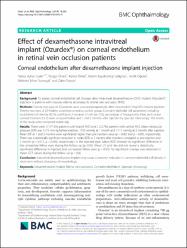| dc.contributor.author | Güler, Hatice Ayhan | |
| dc.contributor.author | Örnek, Nurgül | |
| dc.contributor.author | Örnek, Kemal | |
| dc.contributor.author | Gökçınar, Nesrin Büyüktortop | |
| dc.contributor.author | Oğurel, Tevfik | |
| dc.contributor.author | Yumuşak, Mehmet Erhan | |
| dc.contributor.author | Onaran, Zafer | |
| dc.date.accessioned | 2020-06-25T18:29:26Z | |
| dc.date.available | 2020-06-25T18:29:26Z | |
| dc.date.issued | 2018 | |
| dc.identifier.citation | Güler, H.A., Örnek, N., Örnek, K. et al. Effect of dexamethasone intravitreal implant (Ozurdex®) on corneal endothelium in retinal vein occlusion patients. BMC Ophthalmol 18, 235 (2018). | en_US |
| dc.identifier.issn | 1471-2415 | |
| dc.identifier.uri | https://doi.org/10.1186/s12886-018-0905-0 | |
| dc.identifier.uri | https://hdl.handle.net/20.500.12587/7309 | |
| dc.description | Ornek, Nurgul/0000-0003-3068-1831; Gokcinar, Nesrin Buyuktortop/0000-0001-7795-5188; | en_US |
| dc.description | WOS: 000443738400001 | en_US |
| dc.description | PubMed: 30180837 | en_US |
| dc.description.abstract | Background: To assess corneal endothelial cell changes after intravitreal dexamethasone (DEX) implant (Ozurdex (R)) injection in patients with macular edema secondary to retinal vein occlusion (RVO). Methods: Twenty-two eyes of 22 patients were assessed prospectively after intravitreal 0.7 mg DEX implant injection. Twenty-two eyes of 22 healthy volunteers served as control group. Corneal endothelial cell parameters including endothelial cell density (ECD), coefficient of variation of cell size (CV), percentage of hexagonality (Hex) and central corneal thickness (CCT) were analyzed before and 1 and 3 months after injection by specular microscopy. The results of the study were compared statistically. Results: There were 17 (77.3%) patients with branch RVO and 5 (22.7%) patients with central RVO. Mean intraocular pressure (IOP) was 14.73 mmHg before injection, 17.05 mmHg at 1 month and 17.15 mmHg at 3 months after injection. Mean IOP at 1 and 3 months were significantly higher than pre-injection value (p = 0.002 and p = 0.003, respectively). There was a statistically significant reduction in mean ECD at 3 months after injection compared to pre-injection and 1 month (p = 0.013, p = 0.009, respectively) in the injected eyes. Mean ECD showed no significant difference in the uninjected fellow eyes during the follow up (p>0.05). Mean CV and Hex did not reveal a statistically significant difference in injected and uninjected fellow eyes (p > 0.05). No significant change was observed in mean CCT values during the follow up (p = 0.8). Conclusion: Intravitreal dexamethasone implant may cause a transient reduction in corneal endothelial cell density in short term without changing cell morphology. | en_US |
| dc.language.iso | eng | en_US |
| dc.publisher | Bmc | en_US |
| dc.relation.isversionof | 10.1186/s12886-018-0905-0 | en_US |
| dc.rights | info:eu-repo/semantics/openAccess | en_US |
| dc.subject | Dexamethasone implant | en_US |
| dc.subject | Retinal vein occlusion | en_US |
| dc.subject | Corneal endothelium | en_US |
| dc.subject | Specular microscopy | en_US |
| dc.title | Effect of dexamethasone intravitreal implant (Ozurdex (R)) on corneal endothelium in retinal vein occlusion patients Corneal endothelium after dexamethasone implant injection | en_US |
| dc.type | article | en_US |
| dc.contributor.department | Kırıkkale Üniversitesi, Tıp Fakültesi, Cerrahi Tıp Bilimleri Bölümü | en_US |
| dc.identifier.volume | 18 | en_US |
| dc.relation.journal | Bmc Ophthalmology | en_US |
| dc.relation.publicationcategory | Makale - Uluslararası Hakemli Dergi - Kurum Öğretim Elemanı | en_US |
















